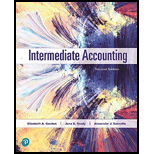
Intermediate Accounting (2nd Edition)
2nd Edition
ISBN: 9780134730370
Author: Elizabeth A. Gordon, Jana S. Raedy, Alexander J. Sannella
Publisher: PEARSON
expand_more
expand_more
format_list_bulleted
Concept explainers
Textbook Question
Chapter 9, Problem 9.6MC
Which of the following disclosures about
- I. Accounts receivable serving as collateral
- II. The percentage used to calculate allowance for doubtful accounts
- III. Total allowance for doubtful accounts
- a. I only
- b. I and II
- c. I and III
- d. I, II, and III
Expert Solution & Answer
Want to see the full answer?
Check out a sample textbook solution
Students have asked these similar questions
What is its DOL? Accounting question
The following data were selected from the records of Fluwars Company for the year ended December 31, current year:
Balances at January 1, current year:
Accounts receivable (various customers)
$
111,500
Allowance for doubtful accounts
11,200
The company sold merchandise for cash and on open account with credit terms 1/10, n/30, without a right of return.
The following transactions occurred during the current year:
Sold merchandise for cash, $252,000.
Sold merchandise to Abbey Corp; invoice amount, $36,000.
Sold merchandise to Brown Company; invoice amount, $47,600.
Abbey paid the invoice in (b) within the discount period.
Sold merchandise to Cavendish Inc.; invoice amount, $50,000.
Collected $113,100 cash from customers for credit sales made during the year, all within the discount periods.
Brown paid its account in full within the discount period.
Sold merchandise to Decca Corporation; invoice amount, $42,400.
Cavendish paid its account in full after the…
I want the correct answer with accounting
Chapter 9 Solutions
Intermediate Accounting (2nd Edition)
Ch. 9 - Prob. 9.1QCh. 9 - Do companies always classify cash as a current...Ch. 9 - Prob. 9.3QCh. 9 - Do accountants typically measure accounts...Ch. 9 - Under the allowance method, will the actual...Ch. 9 - How does an entity record a subsequent recovery of...Ch. 9 - Does the aging of accounts receivable method of...Ch. 9 - What is the difference between pledging accounts...Ch. 9 - How do companies account for receivables that are...Ch. 9 - Is the face value of a note receivable exchanged...
Ch. 9 - What do firms use to record the sales value of a...Ch. 9 - Explain why a company must have highly effective...Ch. 9 - The following are held by YRT Corporation at...Ch. 9 - Fernandez Company had an accounts receivable...Ch. 9 - On its December 31, Year 2, balance sheet, Red...Ch. 9 - Stanberry Company sold 500,000 of net accounts...Ch. 9 - On November 30, Year 1, Derin Corporation agreed...Ch. 9 - Which of the following disclosures about accounts...Ch. 9 - Prob. 9.1BECh. 9 - Prob. 9.2BECh. 9 - Prob. 9.3BECh. 9 - Prob. 9.4BECh. 9 - Prob. 9.5BECh. 9 - Sales Discounts, Most-Likely-Amount Method. On...Ch. 9 - Allowance for Uncollectible Accounts, Write-Off....Ch. 9 - Allowance for Uncollectible Accounts, Write-Off....Ch. 9 - Allowance for Uncollectible Accounts, Recovery....Ch. 9 - Bad Debt Expense, Journal Entry. Paul Anchor...Ch. 9 - Bad Debt Expense. Journal Entry. Paul Anchor,...Ch. 9 - Bad Debt Expense, Aging of Accounts Receivable,...Ch. 9 - Bad Debt Expense, Aging of Accounts Receivable,...Ch. 9 - Prob. 9.14BECh. 9 - Prob. 9.15BECh. 9 - Assigned Receivables. Using the information...Ch. 9 - Factoring Receivables without Recourse. Nicks...Ch. 9 - Prob. 9.18BECh. 9 - Notes Receivable. Welk Associates sold a piece of...Ch. 9 - Prob. 9.20BECh. 9 - Prob. 9.21BECh. 9 - Prob. 9.22BECh. 9 - Internal Controls. Identify whether the following...Ch. 9 - Prob. 9.24BECh. 9 - Prob. 9.25BECh. 9 - Prob. 9.26BECh. 9 - Prob. 9.27BECh. 9 - Prob. 9.28BECh. 9 - Prob. 9.1ECh. 9 - Volume Discounts, Sales Discounts. Sodesta Company...Ch. 9 - Allowance for Uncollectible Accounts, Journal...Ch. 9 - Bad Debt Expense, Aging of Accounts Receivable....Ch. 9 - Bad Debt Expense, Write-Offs, Journal Entry....Ch. 9 - Bad Debt Expense, Aging of Accounts Receivable,...Ch. 9 - Bad Debt Expense, Aging of Accounts Receivable,...Ch. 9 - Bad Debt Expense, Percentage of Accounts...Ch. 9 - Prob. 9.9ECh. 9 - Assigning Receivables, Factoring Receivables....Ch. 9 - Prob. 9.11ECh. 9 - Factoring Receivables with and without Recourse....Ch. 9 - Factoring Receivables without Recourse, Factoring...Ch. 9 - Prob. 9.14ECh. 9 - Prob. 9.15ECh. 9 - Notes Receivable with Year-End Interest Accrual,...Ch. 9 - Prob. 9.18ECh. 9 - Allowance for Uncollectible Accounts, Journal...Ch. 9 - Prob. 9.2PCh. 9 - Allowance for Uncollectible Accounts, Aging of...Ch. 9 - Prob. 9.4PCh. 9 - Bad Debt Expense, Aging of Accounts Receivable....Ch. 9 - Bad Debt Expense, Aging of Accounts Receivable,...Ch. 9 - Prob. 9.7PCh. 9 - Prob. 9.8PCh. 9 - Aging of Accounts Receivable, Write-Offs,...Ch. 9 - Disclosure. Using the transactions listed in P9-9,...Ch. 9 - Accounts Receivable Disclosure. Using Kellogg...Ch. 9 - Prob. 1JCCh. 9 - Financial Statement Analysis Case: Revlon The...Ch. 9 - Prob. 1SSCCh. 9 - Surfing the Standards Case 2: Costs Associated...Ch. 9 - Prob. 1BCC
Knowledge Booster
Learn more about
Need a deep-dive on the concept behind this application? Look no further. Learn more about this topic, accounting and related others by exploring similar questions and additional content below.Similar questions
arrow_back_ios
SEE MORE QUESTIONS
arrow_forward_ios
Recommended textbooks for you
- Principles of Accounting Volume 1AccountingISBN:9781947172685Author:OpenStaxPublisher:OpenStax College
 College Accounting (Book Only): A Career ApproachAccountingISBN:9781337280570Author:Scott, Cathy J.Publisher:South-Western College Pub
College Accounting (Book Only): A Career ApproachAccountingISBN:9781337280570Author:Scott, Cathy J.Publisher:South-Western College Pub Auditing: A Risk Based-Approach (MindTap Course L...AccountingISBN:9781337619455Author:Karla M Johnstone, Audrey A. Gramling, Larry E. RittenbergPublisher:Cengage Learning
Auditing: A Risk Based-Approach (MindTap Course L...AccountingISBN:9781337619455Author:Karla M Johnstone, Audrey A. Gramling, Larry E. RittenbergPublisher:Cengage Learning  College Accounting, Chapters 1-27AccountingISBN:9781337794756Author:HEINTZ, James A.Publisher:Cengage Learning,
College Accounting, Chapters 1-27AccountingISBN:9781337794756Author:HEINTZ, James A.Publisher:Cengage Learning,

Principles of Accounting Volume 1
Accounting
ISBN:9781947172685
Author:OpenStax
Publisher:OpenStax College

College Accounting (Book Only): A Career Approach
Accounting
ISBN:9781337280570
Author:Scott, Cathy J.
Publisher:South-Western College Pub

Auditing: A Risk Based-Approach (MindTap Course L...
Accounting
ISBN:9781337619455
Author:Karla M Johnstone, Audrey A. Gramling, Larry E. Rittenberg
Publisher:Cengage Learning

College Accounting, Chapters 1-27
Accounting
ISBN:9781337794756
Author:HEINTZ, James A.
Publisher:Cengage Learning,
ACCOUNTING BASICS: Debits and Credits Explained; Author: Accounting Stuff;https://www.youtube.com/watch?v=VhwZ9t2b3Zk;License: Standard Youtube License